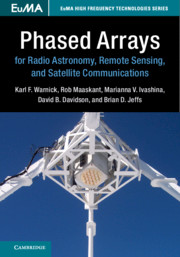Book contents
- Frontmatter
- Contents
- Preface
- Acknowledgements
- Notation and Units
- 1 Phased Arrays for High-sensitivity Receiver Applications
- 2 Active Antenna Receivers
- 3 Antenna Examples
- 4 Transmitting Arrays, Network Analysis, and Pattern Overlap Integrals
- 5 Array Receiver Theory and Modeling
- 6 Figures of Merit for Active Receiving Arrays
- 7 Design and Optimization of Phased Array Antennas
- 8 Numerical Modeling of Phased Array Antennas
- 9 Analog Front End, Array Elements, and Receiver Electronics
- 10 Array Signal Processing, Calibration, and Beamforming
- 11 Interferometric Arrays and Synthesis Imaging
- 12 Real Time Digital Signal Processing
- Index
- References
1 - Phased Arrays for High-sensitivity Receiver Applications
Published online by Cambridge University Press: 14 July 2018
- Frontmatter
- Contents
- Preface
- Acknowledgements
- Notation and Units
- 1 Phased Arrays for High-sensitivity Receiver Applications
- 2 Active Antenna Receivers
- 3 Antenna Examples
- 4 Transmitting Arrays, Network Analysis, and Pattern Overlap Integrals
- 5 Array Receiver Theory and Modeling
- 6 Figures of Merit for Active Receiving Arrays
- 7 Design and Optimization of Phased Array Antennas
- 8 Numerical Modeling of Phased Array Antennas
- 9 Analog Front End, Array Elements, and Receiver Electronics
- 10 Array Signal Processing, Calibration, and Beamforming
- 11 Interferometric Arrays and Synthesis Imaging
- 12 Real Time Digital Signal Processing
- Index
- References
Summary
Phased arrays date back to the very earliest days of radio. The German physicist Karl Ferdinand Braun constructed a three element, switchable array in 1909 to enhance radio transmission in one direction. Early phased arrays achieved beam steering through applying a progressive phase to each element of a one- or two-dimensional array; the concept may be found in almost every book on antenna theory, e.g. [1]. The contemporary usage extends to include control of both the amplitude and phase (or time-delay) excitations of each radiating element in a multiantenna system [2].
While the analytical tools covered in this book are applicable to phased array antennas for all applications, the concepts and examples in the book are organized around the design and optimization of high-sensitivity radio frequency and microwave receivers. Radio astronomy is an especially challenging application of this technology, and will feature strongly in this book. Although parabolic dishes have dominated antenna technology since the early 1960s, to the point where dishes have become largely synonymous with radio telescopes in the popular imagination,1 many early discoveries in radio astronomy were made using phased arrays [3]. The same is true for the large dishes (often over 30 m in diameter) used by telecommunication ground stations and for deep space tracking in the same timeframe; but again, phased arrays were far from forgotten, playing an important role in the first Approach and Landing System (ALS) and post- WWII early warning systems.
Parabolic dishes have probably reached the apogee of their design in recent years, and since they are fundamentally large mechanical systems, their cost is dominated by the cost of materials and labour – neither of which is likely to change dramatically in the foreseeable future. In the radio astronomy community, the currently accepted guideline is that the cost of a dish scales since the area only increases as, building ever-larger steerable dishes is clearly not a viable method for increasing sensitivity, which is directly proportional to collecting area. Additionally, steerable dishes in particular involve moving parts, bringing significant maintenance requirements. Phased arrays, on the other hand, are fundamentally electronic systems, whose cost is increasingly dominated by processing. Moore's Law provides the prospect of continuing – and dramatic – reductions in processing costs.
- Type
- Chapter
- Information
- Publisher: Cambridge University PressPrint publication year: 2018

